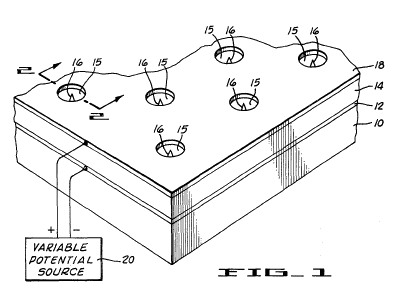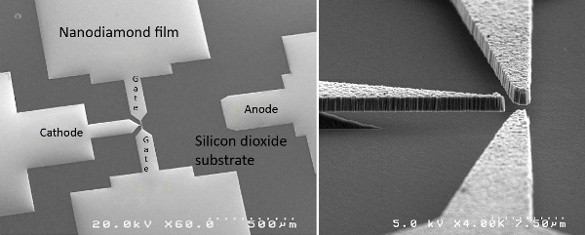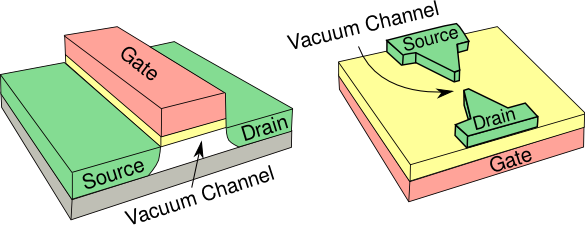Vacuum Transistors
July 11, 2014
Stating the obvious,
electronic materials have the limitation that they're composed of
matter. In that sense they're subject to material limitations, such as
electrical conductivity when it isn't desired, and speed-limiting
permittivity. As its name implies, permittivity is a measure of how a material will permit passage of an
electric field. Material limitations are the reason for a revival of interest in
vacuum electronic devices. I've written two previous articles on this topic,
Vacuum Tube Redux (August 9, 2011), and
Vacuum Transistor (May 23, 2012).
The first vacuum electronic device was the
vacuum tube, a component that defined
electronics through the
1950s. One indication of both the ubiquity and the lack of
reliability of vacuum tubes was the presence of vacuum tube testers at the corner
drug store. You could test the vacuum tubes from your
television,
radio, and
record player, there, and buy replacements.
Vacuum tubes had a few advantages over early
transistors. They were operable over a wider
frequency range and at higher
power. In the first few decades after the
invention of the transistor, it wasn't possible to have a transistorized
FM radio, or a transistorized
guitar amplifier. As transistors increased in quality and declined in cost, vacuum tube
technology was abandoned. There was an attempt by
RCA to miniaturize vacuum tubes, but its
nuvistor needed a
heated cathode to generate an
electron beam by
thermionic emission.
Thermionic emission isn't the only way to generate electrons. The large electric field at the tip of a pointed
conductor will produce electrons by
field electron emission. In theory, the electric field there is
infinity, which would definitely remove electrons from a conductor. In practice, the electric field, as defined by the
Fowler–Nordheim equations, is large, but less. The importance of these
equations by
British physicist,
Ralph H. Fowler and
German-
American physicist,
Lothar Nordheim was underscored to me by the phenomenal number of times they were mentioned by the
professor of one of my
graduate courses.
In the
1970s,
Charles Spindt and his
colleagues at the
Stanford Research Institute (Menlo Park, California) fabricated miniaturized field emission vacuum tubes by the same
planar processing techniques used for
integrated circuits.[1-2] These devices, as illustrated in the figure, also worked at a lower
voltage than thermionic vacuum tubes because of their small dimension.

Fig. 1 of US Patent No. 3,755,704, "Field Emission Cathode Structures And Devices Utilizing Such Structures," by Charles A. Spindt, Kenneth R. Shouldersand Louis N. Heynick, August 28, 1973.
(Via Google Patents).[2)]
The electrical characteristics of the Spindt architecture were somewhat difficult to control, but in 2011, a
research team from
Vanderbilt University made a field emission device from
diamond, as shown in the figure.[3-4] Production of diamond layers is presently fairly routine using the
reaction of a
hydrogen with
methane. Diamond has an extremely low
work function, so it will produce field emission electron beams at low
voltage.[5]
 Left, electron micrograph of a nanodiamond field emission device. Right, detail of the device, showing the nanodiamond field emitter cantilevered above the insulating silicon dioxide surface. The silicon dioxide layer is on a silicon wafer. (Images, Davidson Lab, Vanderbilt University).[3]
Left, electron micrograph of a nanodiamond field emission device. Right, detail of the device, showing the nanodiamond field emitter cantilevered above the insulating silicon dioxide surface. The silicon dioxide layer is on a silicon wafer. (Images, Davidson Lab, Vanderbilt University).[3]
The diamond devices are operable from
liquid nitrogen temperature (77
K) all the way to about 500
°C. They would also be inherently
radiation resistant, so they would be useful in
satellites and
spacecraft. Two problems with this architecture are the definition of the
gate, and the fact that some
current is drawn through the gate.
Scientists from the
NASA Ames Research Center (Moffett Field, CA) developed a planar process electron emission device in 2012 that they call a "
vacuum channel transistor."[6] They built on previous work by the
National Nanofab Center (Daejeon, Korea).[7-8] The device, as shown in the figure, uses a vertical architecture like the geometry of a standard
MOSFET.

The 2012 (left) and 2014 (right) versions of the NASA Ames Research Center vacuum channel transistor. (Illustration by the author using Inkscape.)
The spacing between the electron emitter and collector can be made as small as 150
nm, which allows operation at less than 10 volts. These devices functioned to 460
GHz, and operation at
terahertz range is predicted.[6]
The
mean free path of electrons in
air is longer than the gap, so this vacuum device doesn't really need a vacuum. If the gas,
helium, is used, instead of air, the mean free path is 1000 nm. Since the
velocity of electrons in semiconductors is only as high as 5 x 10
7 cm/sec, while it's 3 x 10
10 cm/
sec in a vacuum, operation at high frequencies is assured.
The Ames team has updated their architecture by bottom gating, also shown in the figure.[9-10] Although the Ames vacuum channel transistor operates at ten volts, which is much higher than the 1.2-1.6 volt range of the present generation of MOSFETs, operation at lower voltage has been reported by others.[9] Sharper points might help, but there might be at a detriment to
lifetime.[9]
The Ames team next plans to demonstrate the first vacuum channel transistor
integrated circuit.[9] There's still some competition from
semiconductor transistors. Operation of
silicon-germanium transistors has been demonstrated at 417
GHz at
room temperature.[10] As I've repeatedly written, many scientific discoveries
happen by chance. The Ames research started with an experiment to
oxidize a
nanowire. The oxidation divided the wire into two pieces, and it was realized that such nanogaps might be useful.[9]
References:
- C. A. Spindt, "A Thin‐Film Field‐Emission Cathode," Journal of Applied Physics, vol. 39, no. 7 (June 1, 1968), pp. 3504-3505
- Charles A. Spindt, Kenneth R. Shouldersand Louis N. Heynick, "Field Emission Cathode Structures And Devices Utilizing Such Structures," US Patent No. 3,755,704, August 28, 1973
- H. Dyball, "A diamond in the making," Electronics Letters, vol. 47, no. 16 (August 4, 2011), pp. 890ff., DOI:10.1049/el.2011.2314.
- David Salisbury, "Designing diamond circuits for extreme environments," Vanderbilt University Press Release, Aug. 4, 2011
- L. Diederich, O.M. Küttel, P. Aebi and L. Schlapbach, "Electron affinity and work function of differently oriented and doped diamond surfaces determined by photoelectron spectroscopy," Surface Science, vol. 418, no. 1 (1998), pp. 219-239
- Jin-Woo Han, Jae Sub Oh, and M. Meyyappan, "Vacuum nanoelectronics: Back to the future?—Gate insulated nanoscale vacuum channel transistor," Appl. Phys. Lett., vol 100, no. 21 (May 21, 2012), Document No. 213505, DOI: 10.1063/1.4717751
- Gyu Hyeong Cho, Ji Yeoul Ryoo, Myeoung Wun Hwang, Min Hyung Cho, Young Jin Woo and Young Ki Kim, "Vacuum Field Transistor," US Patent No. 6,437,360, August 20, 2002
- Dae Yong Kim and Hyun Tak Kim, "Vacuum Channel Transistor and Manufacturing Method thereof," US Patent No. 8,159,119, April 17, 2012
- Jin-Woo Han and Meyya Meyyappan, "Introducing the Vacuum Transistor: A Device Made of Nothing," IEEE Spectrum, June 23, 2014.
- Peter Bright, "NASA melds vacuum tube tech with silicon to fill the terahertz gap," Ars Technica, June 24, 2014.
Permanent Link to this article
Linked Keywords: Electronics; electronic; material; matter; electrical conductivity; permittivity; electric field; vacuum; vacuum tube; 1950s; reliability; drug store; television; radio; phonograph; record player; transistor; frequency; electric power; invention; FM radio; guitar amplifier; technology; RCA; nuvistor; electric heating; heated; hot cathode; cathode ray; electron beam; thermionic emission; electrical conductor; field electron emission; infinity; Fowler-Nordheim equations; United Kingdom; British; physicist; Ralph H. Fowler; German; American; Lothar Wolfgang Nordheim; professor; graduate school; graduate course; 1970s; Charles Spindt; colleague; SRI International; Stanford Research Institute (Menlo Park, California); photolithography; planar processing techniques; integrated circuit; voltage; research; Vanderbilt University; diamond; chemical vapor deposition of diamond; reaction; hydrogen; methane; work function; voltage; electron microscope; electron micrograph; electrical insulator; insulating; silicon dioxide; silicon; wafer; liquid nitrogen; temperature; kelvin; celsius; radiation hardening; radiation resistant; satellite; spacecraft; gate; electric current; NASA Ames Research Center (Moffett Field, CA); vacuum; National Nanofab Center (Daejeon, Korea); MOSFET; Inkscape; nanometer; nm; hertz; GHz; terahertz radiation; mean free path; atmosphere of Earth; air; helium; ballistic conduction; velocity; centimeter; cm; second; sec; service life; lifetime; integrated circuit; semiconductor; silicon-germanium; room temperature; serendipity; oxide; oxidize; nanowire; Charles A. Spindt, Kenneth R. Shouldersand Louis N. Heynick, "Field Emission Cathode Structures And Devices Utilizing Such Structures," US Patent No. 3,755,704, August 28, 1973.